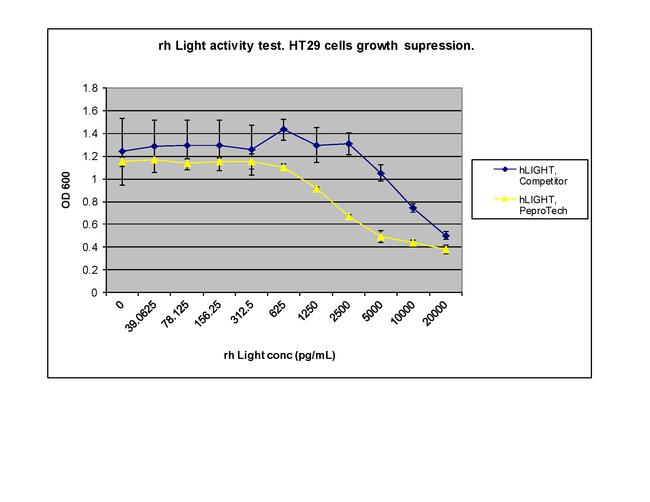Product Details
310-09B-15UG
Species
Expression System
Amino acid sequence
Molecular weight
Class
Type
Purity
Endotoxin concentration
Activity
Conjugate
Form
Purification
Contains
Storage conditions
Shipping conditions
Product Specific Information
310-09B-100UG will be provided as 15 µg (310-09B-15UG) vials.
310-09B-1MG will be provided as 15 µg (310-09B-15UG) vials.
310-09B-250UG will be provided as 15 µg (310-09B-15UG) vials.
310-09B-500UG will be provided as 15 µg (310-09B-15UG) vials.
Recombinant Human LIGHT has a calculated mass of 19.3 kDa, containing 177 amino acid residues. Due to glycosylation, LIGHT migrates between 20.0-22.5 kDa by SDS-PAGE under non-reducing conditions. *Human LIGHT(Catalog Number 310-09B) has replaced Human LIGHT(Catalog Number 310-09)
This product is shipped at ambient temperature. For storage, handling and reconstitution information, please see the lot-specific Certificate of Analysis
Target Information
Apoptosis, or programmed cell death, occurs during normal cellular differentiation and development of multicellular organisms. Apoptosis is induced by certain cytokines including TNF (tumor necrosis factor) and Fas ligand of the TNF family through their death domain containing receptors, TNFR1 (tumor necrosis factor receptor 1) and Fas. Cell death signals are transduced by death domain (DD)-containing adapter molecules and members of the ICE (interleukin-1-beta converting enzyme)/CED-3 (C. elegans death receptor-3) protease family. A novel DD-containing molecule was recently cloned from mouse, human and monkey and designated Daxx (death associated protein 6). Daxx binds specifically to the Fas death domain and enhances Fas induced apoptosis and activates the Jun N-terminal kinase (JNK) pathway. Daxx is widely expressed in fetal and adult human and mouse tissues indicating its important function in Fas signaling pathways.
For Research Use Only. Not for use in diagnostic procedures. Not for resale without express authorization.
References (0)
Bioinformatics
Protein Aliases: CD258; Herpes virus entry mediator ligand; herpesvirus entry mediator ligand; HVEM-L; sCD258; sLIGHT; soluble CD258; soluble LIGHT; tumor necrosis factor (ligand) superfamily, member 14; tumor necrosis factor ligand 1D; Tumor necrosis factor ligand superfamily member 14
Gene Aliases: CD258; HVEML; LIGHT; LTg; TNFSF14; UNQ391/PRO726
UniProt ID: (Human) O43557
Entrez Gene ID: (Human) 8740

We're here to help
Get expert recommendations for common problems or connect directly with an on staff expert for technical assistance related to applications, equipment and general product use.
Contact tech support


